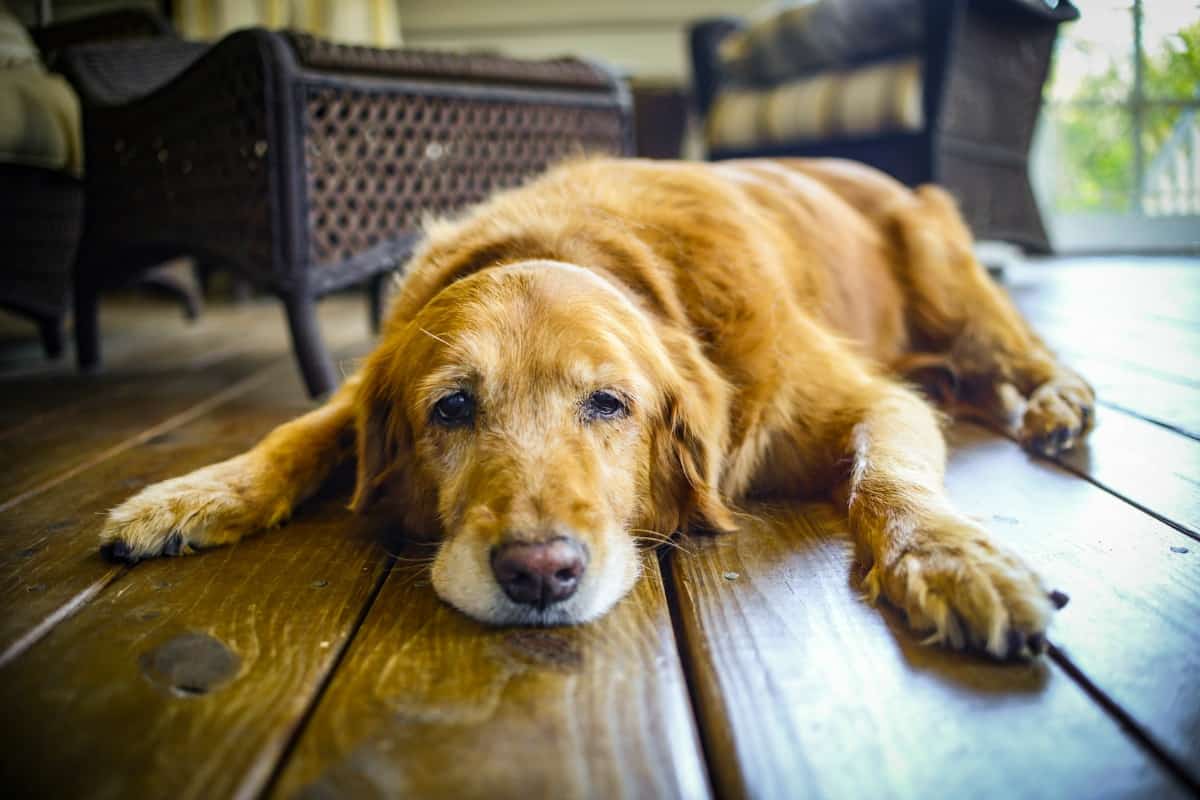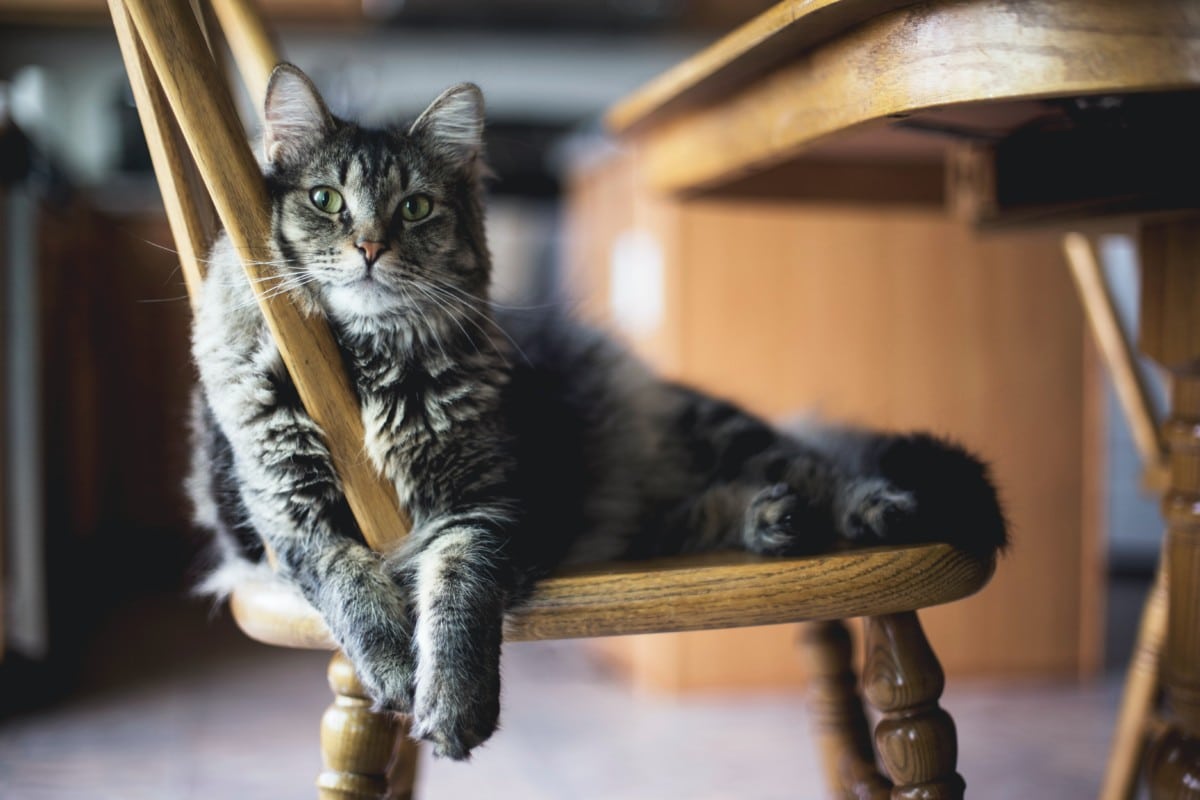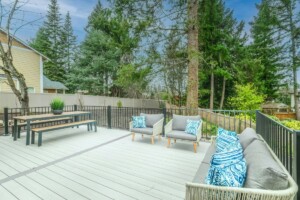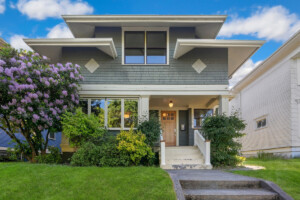There is a shifting cultural change in how people see their pets — they’re not just pets, but family members. We love them so much that their presence in our lives improves our mood and our relationships with other people, all while promoting a host of physical benefits. Our relationship with our pets makes them feel good too! They look to us not only for food and shelter but love and support as well.
As they age, of course, they need more support from us. Elderly pets have a higher risk of arthritis and joint problems, weakness, heart disease, kidney disease, senility, and dental problems, so they need extra assistance around the house as their bodies change. Whether you live in a single-story home in Portland or a multi-level townhouse in New York, simple home modifications can offset the difficulties of aging for our furry family members.
Since cats and dogs are by far the most commonly owned pets in the United States, they’re the pets we’re focusing on in this article.

How Old is ‘Old’?
You may be wondering how you know when your pet is old enough to need extra care. It is common to not know the exact age of your cat or dog, especially if you brought home a rescue pet. Generally, a cat or dog is considered elderly when they reach six or seven years of age. For dogs, however, size factors into age because larger dogs have shorter life spans. For example, a dog weighing between one and 50 pounds is the human equivalent of about 45 years old at seven years, whereas a dog weighing above 50 pounds is the human equivalent of about 55 years old at seven years. Cats tend to have longer lifespans than dogs, so depending upon weight and breed, some cats may not be considered an elderly pet until they reach 10 or 11 years of age.
If you have no idea how old your pet is, it would be beneficial to visit your veterinarian and have them examine your pet’s teeth to give you a rough estimate of their age. Signs of aging to look out for in dogs include:
- graying hair around the muzzle and eyes
- less energy
- lower caloric requirements from food
- calluses on their elbows
- brittle nails
- thickened paw pads
- dental issues
- urinary incontinence
- prostate enlargement
- symptoms of cognitive dysfunction
Did you know?
“One of the most important and often neglected considerations for an elderly dog in the home is the potential for significant changes in relationships with other dogs that are in the home. The deterioration, diseases, and disabilities that elderly dogs often experience both physically and cognitively can compromise their ability to recognize, understand, and respond to important canine social cues and boundaries – negatively impacting the relationship between the dogs in the home as misunderstandings often increase. Senior dogs often experience chronic pain and feel acutely aware of their vulnerability in regards to other animals, making them feel more defensive and irritable than they were in their younger years.” – Kim Brophey, Applied Ethologist, Owner of The Dog Door Behavior Center
A lot of the signs of aging in cats look similar to those of dogs, but cats require more calories as they age rather than fewer, their vision problems are worse than those of aging dogs, and they deal with stress more poorly than aging dogs. If you are unaware of your animal’s age and have not yet asked your veterinarian, be on the lookout for these external signs of aging.
Try this:
“Most aging pets will suffer from degraded vision as they get older and may even lose their vision completely. Your pet will rely on its familiarity with your home to move around safely, so avoid making major changes, such as drastically rearranging furniture.” – Scout
“Many pets start to have a decline in their eyesight so it is crucial to block off any staircases that your pet might be at risk of falling down. Depending on the height of your pet you also may want to “nerf” corners of tables and any other furniture that may be at eye level. There are tons of great baby-proofing products out there that can double as a way to senior pet-proof your home for your aging fur friends.” – Dan’s Dog Walking and Pet Sitting
Height and Mobility
As your pet ages, it may become more difficult for them to lower their neck to eat food or drink water. You may invest in a new raised platform, but it is simpler to use something around the house, such as a shoebox, to elevate the food and water bowls your animal already uses. It is also a good idea to provide several locations with access to fresh, clean water due to your pet’s decreased mobility, increased dehydration, and increased risk of kidney dysfunction. Food bowls for cats should be placed away from cat flaps, glass windows that reach the floor, and their litter boxes. They should also be placed in a location where your cat can approach from any direction and not be forced to have their back exposed to other animals in the household.
For older cats, arthritis and shrinking kidneys contribute to issues using their litter boxes. They may not be able to get in and out of their litter box or they may not be able to squat down to relieve themselves, resulting in spray on and over the sides of the box. There are litter boxes on the market with lower openings designed for older cats, but you can also use a storage bin with an entryway cut out in the front as a modification. This way, the sides of the box will be higher and better prevent accidents. If you have multiple cats in your household, you should have one litter box for each cat, plus an extra. They should be spread out, as cats are territorial and may try to prevent their housemates from having access to litter boxes.

Arthritis is a common problem in dogs as well. In fact, over 60 percent of dogs over the age of seven have developed arthritis. Arthritis, as well as other joint issues, can cause your canine pain, limping, and difficulty getting up or climbing stairs. An easy home modification to enable easier mobility for your elderly pet is to buy or build a ramp or shallow stairs. A ramp or stairs allows your animal the same freedom and access to couches, beds, and cars that they had when they were younger. Cats particularly love to sit in windowsills and look outdoors. A ramp to their favorite lookout spot would be an excellent idea.
Keep the weight in mind when purchasing or constructing this modification, as you may need to move it around for your animal. You can make a ramp out of plywood if it is a more permanent fixture, but if you are seeking portability, try crafting this one out of Styrofoam.
An easy modification you can make to stairs is to install anti-slip treads made from carpet or rubber. If your dog can no longer make it up the stairs at all, place their dog bed in a warm spot downstairs so that they have no need to be anywhere other than the first floor of your home. Placing a bed downstairs is also an easy modification for felines who are no longer able to climb the stairs.
Try this:
“Many elderly dogs experience a decline in mobility and muscle mass, and suffer from arthritis and joint and muscle pain. For dogs that can’t jump up anymore, place stairs or ramps around the house to give them access to your bed or sofa. Block areas of your home that could pose a danger to your dog such as stairs or uneven surfaces in the back yard. Lay carpet runners over wood or tile floors so your dog can walk with ease and without the risk of falling down. Provide a therapeutic bed for better sleep and also so your dog is more comfortable when they are resting during the day. –Fitdog
“Feed your dog on a raised platform to make it easier on their neck and back. This is even a good idea for younger dogs, but senior dogs need extra help so they don’t have to strain while they are trying to enjoy a meal.” –The Pooch Coach
“It is important to keep your aging pets active while limiting any overexertion. Encourage slow walking and the use of stairs every day to help make sure core muscles and legs stay strong. Keep ramps or portable steps in the house to help bridge any physical gaps and consult with your doctor to make sure your pets are getting the right supplements to help keep them active and sharp. Consider acupuncture or hydrotherapy, and extra at-home time to comfort your pet.” – Pet Check
“Since elderly or even middle-aged dogs may struggle with keeping their footing on slick non-carpeted floors, a smart investment might be a stick-on floor mat that stays put but provides the traction your senior pup needs to stay upright when navigating your home. As hard as it can be to see our senior dogs struggle, it’s important to avoid jumping up in alarm every time your pup slips or tumbles, as this can add to their stress about the event. If you see your senior dog struggling, calmly and quietly get up and go assist them to a more comfortable position.” –Summit Dog Training
“Having an elderly pet does not mean that you need to uproot the way you live, and with a few simple changes, your home can become “elderly pet-friendly.” Jumping, running, and even getting down from furniture become painful and problematic for pets. Doggy stairs are fluffy and portable so they can be used at your bedside, sofa, or even to climb up to their favorite window sill. The stairs allow your pet to resume the activities they love in the places they love without the risk of exacerbating joint conditions.” Lauren Cora, Dogs Deserve It
Adjusting for Behavioral Changes
Urinary incontinence is when your animal companion cannot control the flow of urine from being released. It occurs in both elderly cats and dogs, albeit for different physiological reasons. Incontinence can create a lot of mess and odor, but there are some home modifications to circumvent the worst of it.
If you have the financial ability to alter the flooring of your home, try installing ceramic tile or carpet tiles designed for pet incontinence. If you are unable to alter your flooring or already have hard flooring that is easy to clean, invest in non-slip rugs, carpet runners, or even yoga mats for better traction for your elderly pet. Seek out materials that are easy to wash and do not absorb stains and odors quickly.
Another home modification for urinary incontinence is a doggy door or dog flap. These can provide the freedom for your canine to urinate outside as they need. You will want to install the door in a low area to provide ease of access for any mobility issues. Some dog flaps have magnets to adhere the flap to the door, but the magnets can make it more difficult for your elderly pet to push the door open. You also have the option of a magnetic door that operates in tandem with your pet’s collar. When they go to enter or exit your home, the door senses their presence and opens automatically for them.
As we’ve already learned, elderly pets suffer from arthritis and joint pain. Aging in your pets also causes nerve degeneration, muscle weakness, and cognitive decline, which all contribute to the inability to move around as efficiently as younger animals. We have already discussed the need for ramps or special stairs, but your elderly pet might also need special bedding. If your dog displays any of the behavioral symptoms of joint problems, an orthopedic bed is specifically designed for their needs. Orthopedic beds often offer special features to work in conjunction with your dog’s other physical needs, such as being made of memory foam as well as liquid and stain-resistant fabric. Smaller dogs should sleep in a bed relative to their size because they get cold more easily and may feel insecure in a larger bed. If you have a dog flap installed, place the dog bed near the door for easy access to the bathroom.
If your pet is an older cat, place their bed within the vicinity of their litter box, but not too close to it. Place their ramp near their favorite sleeping spot so they have easy access — they will still want to sleep in a high corner if that’s where they’re used to turning in each night. Cats also enjoy cave-style beds just like their ancestors. If it is more difficult for your feline to reach their favorite slumber spot, consider making a cocoon-like bed in a corner under a table in a spot that is difficult for other cats to reach them.
Try this:
“It’s important to remember that as your dog gets older, they also will not be able to last quite so long between potty breaks anymore. Try to plan out your workday so you can give them more frequent breaks outside or hire a trusted dog walker to visit with your dog. It will be a bright point in your dog’s day to be able to get some extra love, a little exercise to keep them agile, and some treats to bring them a little extra joy.” – Charleston Dog Walker
“An indoor potty solution for elderly pets gives them the freedom they deserve when it comes to potty time. Consider purchasing a grass patch from real grass as these are low maintenance, eco-friendly, and often require little to no training because dogs are already used to going potty on real grass. With the indoor potty solution, elderly dogs can use the bathroom whenever they need too, while also avoiding going up and down steps which can be painful for dogs with arthritis.” – DoggieLawn
“Limit the movement for your elderly pet and this begins with consolidating their living space. Move their bed, eating, and drinking dish into the same area of the home to avoid added walking. This allows your senior pet to conserve their energy for more important times.” – Prudent Pet
“As your dog ages, stairs can become more difficult to navigate. Keep your dog confined to the main floor and set up a secure area for your dog’s food and water dishes. Older dogs sometimes have difficulty sleeping through the night and tend to take more naps. To ensure your elderly dog gets quality sleep, consider getting him an orthopedic bed, and creating a safe space for your dog to sleep where he won’t be interrupted by foot traffic from family members.” – Dog’s Best Life
“Consider incorporating runner rugs down everywhere. Runner rugs allow your aging pet’s paws to grip and not slip, and help give support to those pets with weakening or arthritic legs.” – The Pet Lifestyle Guru
“Non-slip carpet runners can make a big difference in helping your pup live out their golden years comfortably. If your dog has trouble moving up and downstairs, let them outside at the door with the least amount of stairs and try making or buying a ramp for them to use.” – Sidewalk Dog
“Your senior pet may need a comfortable place where they can safely relax, yet still be close to the family. A modern looking dog pen can fit seamlessly with any decor. These modular enclosures come in a variety of sizes, colors, and configurations to meet your needs and express your style.” – Clearly Loved Pets
“Older dogs need soft, easy-to-enter and exit dog beds. With just a little research, you’ll find that there are countless options with a range of different features. We recommend purchasing a bed with super-soft fabric and surrounding pillowy bolsters with loftier center that won’t flatten. – West Paw
“You want to ensure that your dog has easy access to go outside. If you have stairs in your hallway you might have to start carrying them over the stairs. If your pet uses the bathroom inside your home, set up the litter or Weewee pads so they’re easy to clean and away from food area.” –NY Tails
Physiological Health
Older animals have more difficulty regulating their body temperature, so they are more sensitive to temperature changes and temperature that varies significantly from their own body temperature. Set your thermostat between 78 and 80 degrees and pay attention to your animal’s specific behavior. If they hang out by a fan or the heater, they may need an adjustment outside of the 78- to 80-degree range.
Both cats and dogs have slightly higher resting body temperatures than humans, so when it is colder outside make sure they have a blanket in their bed and an area to sleep in the sunlight during the day. Also be sure to dress your dog in booties and a sweater when taking them outside to potty, because extreme changes in temperature increase risk of illness.
Mental Health
There are also some simple home modifications you can make to improve your animal’s mental health.
Elderly pets have a reduced capacity to handle stress and are more likely to feel anxiety in response to change and other stressful situations. This can be due to their bodies’ decreased production of adrenal hormones or the amount of other health issues they may have due to their age.
There are several key ways of identifying signs of anxiety in your dog:
- increased panting
- trembling
- sleep issues or restlessness
- loss of appetite
- separation anxiety, even when you’re at home with them
- loss of bladder control (which is more severe than bladder incontinence)
- disinterest or lethargy
- significant barking or whining when left alone
Dogs are creatures of habit, so keeping their routine consistent will help mitigate anxiety. This goes for cats as well. As cats age, anxiety can be caused by disorientation and confusion, so a regular daily routine and consistent placement of your cat’s litter box, bed, and food is important.
Increased sensitivity to sound is stressful for older animals as well. Keep a white noise machine or background music playing in your home to prevent this source of stress. Breaking up their day with exercise and play is also essential to keeping your elderly pet mentally healthy. Have a play corner in your home where you keep all of your cat or dog’s toys and be sure to regularly engage with them here. Regular playtime in old age can keep your pet physically stimulated as well as mentally, fighting against anxiety and cognitive decline.
Finally, be sure to have space in your home where pet sitters can stay so that if you need to leave your canine companion for an extended amount of time, they can remain in their home where they feel most comfortable.
Try this:
“It is important to keep your aging dog’s brain fit. Simple Nose Work games can help motivate both your dog’s brain and body to stay younger. Scatter treats throughout your home for your dog to hunt and find, or create a “kibble trail” outdoors for a healthy brain game. The dog’s nose is a critical organ and using it this way creates low impact exercise and increased mental stimulation.” – Two Paws Up Dog Training
“With advancements in technology, one of the best gadgets to buy is a robot with a built-in camera. This way you can have peace of mind while away and also give reassurance to your senior pup. Robotic cameras allow you to follow your dog around the house, even encourage them to go outside and stretch their legs, all done remotely so you can work and provide the best care for them.” – Puptown Houston Dog Training
Improved Quality of Life
These home modifications are not just home modifications to your elderly pet. They can improve your animal companion’s entire quality of life and increase their lifespan. It is important to pay close attention to your elderly pet’s behavior to detect signs of aging early on in order to ease their transition into a slower way of life. As pet owners, we are the center of our pet’s lives, and because they see us as their parents, we are the closest relationship bond they will ever have. Even though they are only one part of our lives, they improve our relationships with other people, stress levels and mood, as well as our cholesterol and triglyceride levels — and they deserve to live out their lives with security, comfort, and love.


























 United States
United States Canada
Canada